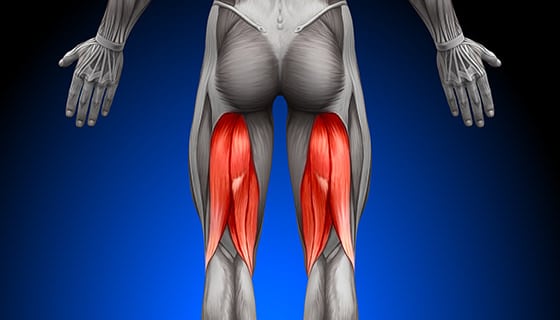Tight hamstrings are often overlooked as a cause of knee pain, but they play a crucial role in the stability and mechanics of the knee joint. Many people experience knee discomfort without realizing that the root cause could be the muscles at the back of their thighs. This article explores the connection between tight hamstrings and knee pain, detailing causes, symptoms, treatments, and prevention methods.
Understanding the Hamstrings and Their Role in Knee Health

The hamstrings are a group of three muscles:
- Biceps Femoris
- Semitendinosus
- Semimembranosus
These muscles run along the back of your thigh, connecting the pelvis to the lower leg. Their primary functions include:
- Bending (flexing) the knee
- Assisting with hip extension
- Stabilizing the knee during movement
When the hamstrings become tight, they can restrict natural knee movements and put extra strain on the joint, leading to discomfort.
How Do Tight Hamstrings Cause Knee Pain?
1. Mechanical Disruption
Tight hamstrings can alter the natural movement of the knee, preventing it from fully straightening. This misalignment puts pressure on the knee joint, which can cause:
- Pain around the kneecap
- Difficulty walking or running
- Limited range of motion
2. Increased Tension on the Knee Joint
When hamstrings are tight, they pull on the knee joint, creating excessive tension on the patella (kneecap) and surrounding structures. This tension is particularly noticeable during activities like:
- Climbing stairs
- Squatting
- Running
The increased pressure can cause patellofemoral pain syndrome or general knee discomfort.
3. Muscle Imbalance
If the hamstrings are tight and the quadriceps (front thigh muscles) are weak, it creates a muscle imbalance. This imbalance reduces knee stability and forces the joint to absorb more impact during movement. Over time, this can contribute to chronic knee pain and injuries.
4. Reduced Shock Absorption
The hamstrings act as natural shock absorbers during physical activities. When they’re too tight, they can’t perform this function effectively, putting more pressure on the knee joint and increasing the risk of:
- Ligament strains
- Cartilage damage
- Chronic knee pain
Symptoms of Knee Pain Caused by Tight Hamstrings
Knee pain from tight hamstrings often presents differently from other types of knee injuries. Common symptoms include:
- Dull ache behind or around the knee
- Tightness in the back of the thigh
- Pain during activities like walking, running, or squatting
- Difficulty straightening the leg
- Knee stiffness after prolonged sitting
- Occasional knee buckling or instability
Risk Factors for Tight Hamstrings
Certain factors make people more prone to tight hamstrings, including:
- Sedentary lifestyle
- Poor posture
- Lack of stretching before exercise
- Overuse during physical activity
- Muscle imbalances between hamstrings and quadriceps
Athletes, older adults, and people who sit for long periods are particularly at risk.
How to Relieve Knee Pain from Tight Hamstrings
1. Stretching Exercises
Regular stretching helps loosen the hamstrings and improve flexibility. Effective stretches include:
Standing Hamstring Stretch
- Stand with one foot in front of the other.
- Bend your back knee and keep the front leg straight.
- Lean forward gently until you feel a stretch in the back of your thigh.
- Hold for 20–30 seconds on each leg.
Seated Forward Bend
- Sit with your legs straight out in front of you.
- Reach for your toes while keeping your knees straight.
- Hold for 20–30 seconds.
Lying Hamstring Stretch (with Towel or Band)
- Lie on your back with one leg extended upward.
- Use a towel or resistance band to pull your leg toward your chest.
- Hold for 20–30 seconds.
2. Strengthening Exercises
Strengthening the hamstrings and surrounding muscles can improve knee stability. Recommended exercises include:
- Leg Curls
- Glute Bridges
- Deadlifts
- Squats
These exercises help balance the muscle groups around the knee joint, preventing future discomfort.
Also Read: Sudden Knee Buckling No Pain – Causes, Symptoms, and Treatment Options!
3. Foam Rolling and Massage
Foam rolling can relieve tension in the hamstrings by breaking up muscle knots and improving blood flow. Roll along the back of the thighs for 1–2 minutes before and after workouts.
4. Physical Therapy
A physical therapist can design a personalized stretching and strengthening program to target hamstring tightness and improve knee function. They may also use treatments like:
- Massage therapy
- Electrical stimulation
- Heat or ice therapy
5. Pain Management
For temporary relief, over-the-counter pain relievers like ibuprofen can reduce inflammation and ease discomfort.
Preventing Knee Pain from Tight Hamstrings
To keep your hamstrings healthy and prevent knee pain:
Stretch daily
Warm up before workouts
Strengthen hamstrings and quadriceps
Avoid sitting for long periods
Use proper footwear during physical activities
When to Seek Medical Attention
Consult a doctor or physical therapist if you experience:
- Persistent knee pain
- Swelling or redness
- Knee instability
- Difficulty walking
- Pain that worsens over time
Early intervention can prevent more serious injuries and long-term knee problems.
FAQ’s
Q: What are the best exercises to strengthen my hamstrings?
Leg curls, glute bridges, deadlifts, and step-ups are great exercises to strengthen hamstrings and improve knee stability.
Q: How can I tell if my knee pain is caused by tight hamstrings?
If your knee pain is accompanied by tightness in the back of your thigh and worsens during leg straightening or physical activity, tight hamstrings may be the cause.
Q: Are there any stretches specifically for tight hamstrings?
Yes, standing hamstring stretches, seated forward bends, and lying hamstring stretches with a towel or band are highly effective.
Q: How does tightness in the hamstrings affect knee stability?
Tight hamstrings can limit knee movement, increase tension on the joint, and reduce muscle support, leading to instability and a higher risk of injury.
Q: Can tight hamstrings lead to other lower back issues?
Yes, tight hamstrings can tilt the pelvis backward, affecting posture and placing extra strain on the lower back, potentially causing discomfort or pain.
Conclusion
Tight hamstrings can cause knee pain by disrupting joint mechanics, increasing tension, and creating muscle imbalances. While the discomfort may seem minor at first, ignoring tight hamstrings can lead to chronic knee problems and a higher risk of injury. By incorporating regular stretching, strengthening exercises, and lifestyle adjustments, you can improve hamstring flexibility, support knee stability, and reduce the risk of knee pain. If you’re experiencing knee pain from tight hamstrings, start with simple stretches and seek medical advice if the pain persists. Taking care of your hamstrings is an essential step toward maintaining long-term knee health.






